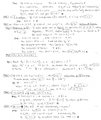12-240/Classnotes for Thursday September 13: Difference between revisions
No edit summary |
|||
| (22 intermediate revisions by 3 users not shown) | |||
| Line 19: | Line 19: | ||
'''F3:''' the existence of identity elements |
'''F3:''' the existence of identity elements |
||
<math>\forall \!\,</math> a <math>\in \!\,</math> |
<math>\forall \!\,</math> a <math>\in \!\,</math>, a+0=a and a.1=a |
||
'''F4:''' existence of inverses |
'''F4:''' existence of inverses |
||
<math>\forall \!\,</math> a <math>\in \!\,</math> F ,<math> \exists \!\, c, d \in \!\ </math> F such that a+c=o and a.d=1 |
<math>\forall \!\,</math> a <math>\in \!\,</math> F \0,<math> \exists \!\,</math> c, d <math>\in \!\ </math> F such that a+c=o and a.d=1 |
||
'''F5:''' contributive law |
|||
<math>\forall \!\,</math> a, b, c <math>\in \!\,</math> F, a.(b+c)=a.b + a.c |
|||
== Theorems == |
|||
'''Theorem 1: Cancellation laws''' |
|||
<math>\forall \!\,</math> a, b, c <math>\in \!\,</math> F |
|||
if a+c=b+c, then a=b |
|||
if a.c=b.c and c<math>\ne \!\,</math>0, then a=b |
|||
'''Theorem 2: Identity uniqueness''' |
|||
Identity elements 0 and 1 mentioned in '''F3''' are unique |
|||
<math>\forall \!\,</math> a, b, b' <math>\in \!\,</math> F |
|||
if a+b=a and a+b'=a, then b=b'=0 |
|||
if a.b=a and a.b'=a and a<math>\ne\!\,</math>0, then b=b'=1 |
|||
'''Theorem 3: Inverse uniqueness''' |
|||
Elements c and d mentioned in '''F4''' are unique |
|||
<math>\forall \!\,</math> a, b, b' <math>\in \!\,</math> F |
|||
if a+b=0 and a+b'=0, then b=b' |
|||
if a.b=1 and a.b'=1, then b=b' |
|||
'''Theorem 4''' |
|||
<math>\forall \!\,</math> a <math>\in \!\,</math> F |
|||
-( -a) = a |
|||
'''Theorem 4''' |
|||
<math>\forall \!\,</math> a <math>\in \!\,</math> F |
|||
0.a= 0 |
|||
== Significance == |
|||
'''inverse uniqueness''' |
|||
It makes sense to define an operation |
|||
-: F -> F called "negation" |
|||
For a <math>\in\!\,</math> F define -a to be equal that b <math>\in\!\,</math> F for which a+b=0, i.e, a+(-a)=0 |
|||
Ex: F(5)={0,1,2,3,4}, define +,x |
|||
Question 1: What is(-3)? |
|||
Answer: -3=2 and -3 is unique |
|||
Similarly, the inverse uniqueness also makes sense a^(-1) |
|||
''' identity uniqueness''' |
|||
== Lecture Notes, upload by [[User:Starash|Starash]] == |
|||
<gallery> |
|||
Image:Mat240 120913 p1.jpg|Page 1 |
|||
Image:Mat240 120913 p2.jpg|Page 2 |
|||
</gallery> |
|||
Latest revision as of 01:01, 23 October 2012
| |||||||||||||||||||||||||||||||||||||||||||||||||||||||||
In the second day of the class, the professor continues on the definition of a field.
Definition of a field
Combined with a part from the first class, we have a complete definition as follow:
A field is a set "F' with two binary operations +,x defind on it, and two special elements 0 ≠ 1 such that
F1: commutative law
a, b F: a+b=b+a and a.b=b.a
F2: associative law
a, b, c F: (a+b)+c=a+(b+c) and (a.b).c= a.(b.c)
F3: the existence of identity elements
a , a+0=a and a.1=a
F4: existence of inverses
a F \0, c, d F such that a+c=o and a.d=1
F5: contributive law
a, b, c F, a.(b+c)=a.b + a.c
Theorems
Theorem 1: Cancellation laws a, b, c F
if a+c=b+c, then a=b
if a.c=b.c and c0, then a=b
Theorem 2: Identity uniqueness
Identity elements 0 and 1 mentioned in F3 are unique
a, b, b' F
if a+b=a and a+b'=a, then b=b'=0
if a.b=a and a.b'=a and a0, then b=b'=1
Theorem 3: Inverse uniqueness
Elements c and d mentioned in F4 are unique
a, b, b' F
if a+b=0 and a+b'=0, then b=b'
if a.b=1 and a.b'=1, then b=b'
Theorem 4
a F
-( -a) = a
Theorem 4
a F
0.a= 0
Significance
inverse uniqueness
It makes sense to define an operation -: F -> F called "negation"
For a F define -a to be equal that b F for which a+b=0, i.e, a+(-a)=0
Ex: F(5)={0,1,2,3,4}, define +,x
Question 1: What is(-3)?
Answer: -3=2 and -3 is unique
Similarly, the inverse uniqueness also makes sense a^(-1)
identity uniqueness








